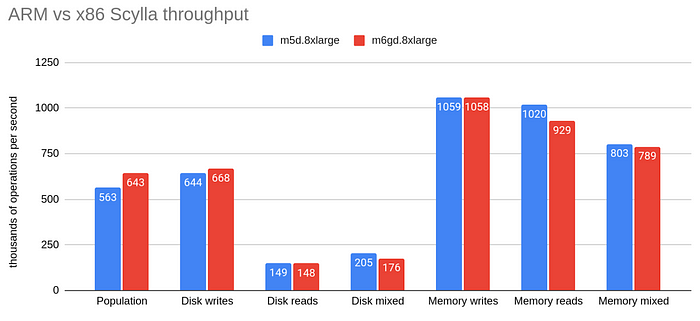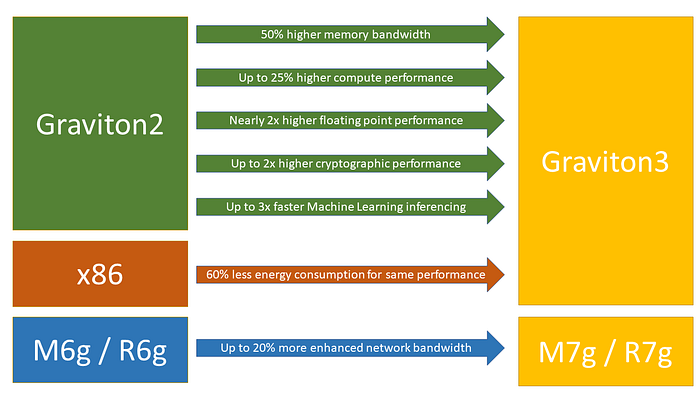AWS Graviton: The future of high-performance and cost-effective Cloud Computing
Say Goodbye to Expensive Computing with AWS Graviton Processors!

Hi there! As a Site Reliability Engineer (SRE), I’m always on the lookout for new technologies that can help improve our cloud infrastructure. One of the most exciting new developments in recent years has been the emergence of AWS Graviton, Amazon’s custom processor based on the Arm architecture. And I have to say, Graviton has me totally excited.
In this blog post, I’ll take you on a deep dive into AWS Graviton, covering everything from its history and technical features to its performance benefits and real-world use cases. We’ll explore the history behind its development, dive deep into its technical features, and explore its mind-blowing performance benefits. Plus, I’ll share some real-world use cases of companies that have successfully deployed Graviton in their cloud infrastructure.
What is an ARM-based processor?

An ARM-based processor is a type of microprocessor architecture designed by the British company, ARM Holdings. ARM stands for “Advanced RISC Machine”, which is a type of reduced instruction set computing (RISC) architecture. RISC architectures simplify the instruction set of a processor, allowing it to execute instructions more quickly and with fewer transistors. The benefits are:
- High performance, with many modern ARM-based CPUs rivaling the performance of x86-based CPUs.
- Cost-effectiveness, as ARM processors are often less expensive than their x86 counterparts.
- Low power consumption, making them well-suited for mobile devices and other battery-powered applications.
- Flexibility and customization, modular design, making it easier to create processors with varying numbers of cores, cache sizes, and other features. One such use case is the in-house developed ARM-based processor by AWS known as ‘AWS Graviton’.
Hence, these processors are widely used in mobile devices, such as smartphones and tablets. Be it an Android phone based on a Snapdragon processor or an iPhone running on A-series bionic chipset, both processors are based on ARM architecture. They are also used in embedded systems, IoT devices, and increasingly in servers and data centers.
AWS Graviton processors
AWS Graviton processors are a family of ARM-based processors that are designed specifically for use in Amazon Web Services (AWS) instances. They are built using a custom design based on ARM’s Neoverse N1 architecture, which provides several unique features and capabilities that set them apart from other ARM-based processors. AWS Graviton processors are designed by AWS to deliver the best price-performance for your cloud workloads running in Amazon EC2.
AWS Graviton vs. traditional x86 processors
Graviton processors offer a great combination of performance, power consumption, and cost savings, making them a compelling alternative to traditional x86 processors for many cloud-based workloads.

Graviton and Intel processors are like two superheroes with different powers. Graviton is optimized for cloud workloads that require high levels of parallel processing, while Intel is designed for a broader range of applications. Graviton uses less power and is generally less expensive than Intel, but Intel has wider software support. It’s like Graviton is the speedster who’s great at running laps around the track, while Intel is the all-around athlete who’s good at everything. Which superhero to choose depends on the specific use case and workload requirements.
AWS Graviton-based services and products
AWS Graviton-based instances are now supported by a wide range of AWS services. It’s worth noting that AWS is actively working on adding support for Graviton instances to more of its services, so the list of Graviton-enabled services is likely to expand in the future.

Accelerate your applications with AWS Graviton processors on EC2

- Improved performance: Graviton processors are optimized for specific workloads, such as web servers, containerized microservices, and data processing, leading to improved performance and faster processing speeds.
- Lower instance costs: Graviton-based instances are priced lower than their x86 counterparts. This might not seem like a big difference, but over time, it can add up to significant cost savings.
- Higher performance per dollar and cost-effective scaling: In my experience, Graviton-based instances offer better performance per dollar than x86 instances. This means that Graviton instances can handle more requests per second or process more data in the same amount of time compared to x86 instances.
- Flexible instance sizes: With Graviton-based instances, you have more flexibility in choosing the right instance size for your workload. AWS offers a range of Graviton instance sizes, from small to extra-large, so you can choose the size that best fits your workload. This means you don’t have to pay for more resources than you need.
- Energy efficiency: Graviton processors are designed to be energy efficient, resulting in lower power consumption and reduced operational costs.
Here are a few examples of cost comparisons between x86-based EC2 instances and Graviton-based EC2 instances:

- General Purpose: For a t3a.medium instance (Graviton2) vs a t3.medium instance (x86), the Graviton-based instance costs 10–20% less per hour.
- Memory-optimized: For an r6g.xlarge instance (Graviton2) vs an r5.xlarge instance (x86), the Graviton-based instance costs 20–25% less per hour.
- Compute-optimized: For a c6g.xlarge instance (Graviton2) vs a c5.xlarge instance (x86), the Graviton-based instance costs 25–30% less per hour.
AWS provides a pricing calculator that allows you to estimate the cost of running instances on different processors, including x86 and Graviton. You can use this tool to compare costs and performance metrics and determine which processor is best suited for your workload.
AWS Graviton3: the newest generation of ARM-based processors from AWS

The picture says it all! Graviton3 is the latest generation of ARM-based processors from AWS, succeeding Graviton2. Graviton3 offers several improvements over Graviton2, including increased performance, enhanced security, and support for more workloads. Graviton3 has up to 40% better price performance compared to Graviton2 and can deliver up to 10 times the performance for machine learning workloads. Graviton3 also supports new technologies like PCIe 4.0 and DDR5 memory, which were not available on Graviton2. Overall, Graviton3 is a significant upgrade from Graviton2 and provides customers with a more powerful and efficient option for running their workloads in the cloud.
Limitations and challenges of using AWS Graviton instances
- Limited software support: Some applications and operating systems aren’t compatible with ARM processors. This requires software to be recompiled or optimized, leading to additional development time and resources.
- Limited third-party tool support: Some third-party tools and software are not yet optimized for Graviton instances, which means they may not perform optimally on ARM processors.
- Migration challenges: Migrating workloads from x86-based instances to Graviton instances may require additional planning and testing to ensure compatibility and performance.
- Debugging challenges: Debugging and troubleshooting issues on Graviton instances may require a different approach compared to x86-based instances due to differences in architecture and tooling support. This could result in additional time and resources spent on debugging.
Despite these challenges, many organizations have successfully migrated to Graviton instances and realized significant cost savings and performance improvements. Therefore, it’s important to weigh the pros and cons and evaluate the suitability of Graviton instances for a specific workload before making a decision.
Real-world success stories: Organizations that have unlocked benefits by migrating to AWS Graviton instances

“As we look to the future and building increasingly immersive and compelling experiences for players, we are excited to use AWS Graviton3-based EC2 C7g instances. Our testing has shown they are suitable for even the most demanding latency sensitive workloads while providing significant price performance benefits and expanding what is possible within Fortnite and any Unreal Engine created experience.”
- Mark Imbriaco, Senior Director of Engineering at Epic Games

“We began using AWS Graviton2-based instances during our summer of major sports broadcasts including the Olympic Games Tokyo 2020. Graviton2 was used in our caching services for our front end Subscriber Management and the Media Asset Management platforms to reach 175M viewers with 7x better performance compared to the x86-based instances we were using previously. As Graviton2 has up to 40% better price performance, Discovery are investigating how to scale further adoption across other use cases.”
- Damien Frost, SVP, Global Infrastructure Services, Discovery
Personally, I have observed notable improvements in performance and cost savings after transitioning from x86 to ARM-based Graviton processors for enterprise workloads. The latest Graviton3 processors have further elevated our application’s performance, particularly in terms of throughput, resource utilization, and cost-effectiveness. I highly recommend trying them out to experience the benefits firsthand!
Thank you for taking the time to read my article! I hope you found it informative and valuable. If you have any feedback, comments, or questions, please feel free to reach out 😄
I look forward to sharing more content with you in the future! 🤘
